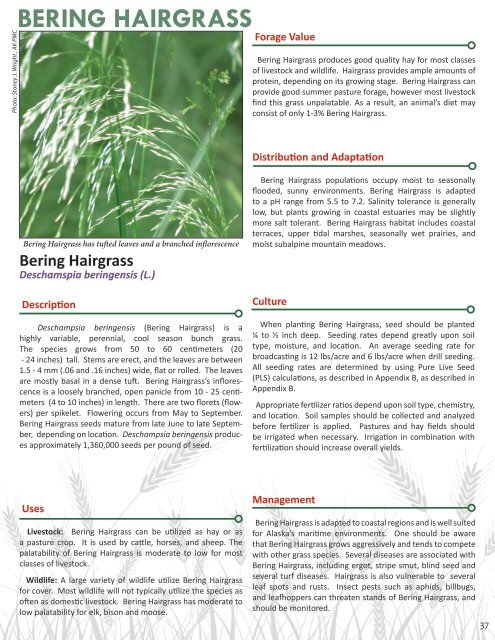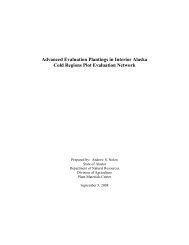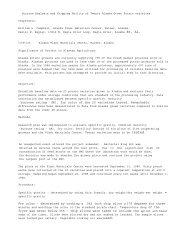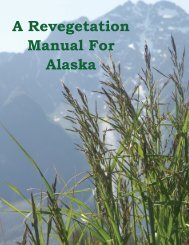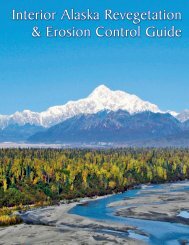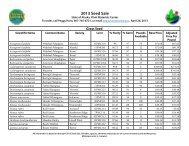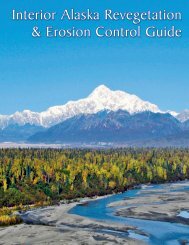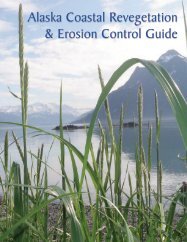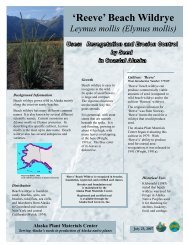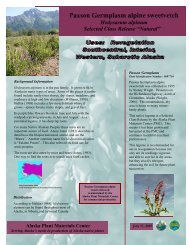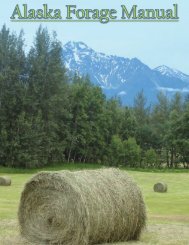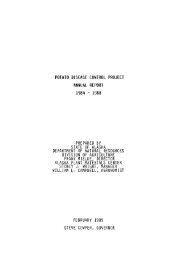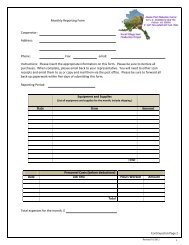Alaska Forage Manual - Alaska Plant Materials Center - State of ...
Alaska Forage Manual - Alaska Plant Materials Center - State of ...
Alaska Forage Manual - Alaska Plant Materials Center - State of ...
Create successful ePaper yourself
Turn your PDF publications into a flip-book with our unique Google optimized e-Paper software.
Photo: Stoney J. Wright , AK PMC<br />
BERING HAIRGRASS<br />
<strong>Forage</strong> Value<br />
Bering Hairgrass produces good quality hay for most classes<br />
<strong>of</strong> livestock and wildlife. Hairgrass provides ample amounts <strong>of</strong><br />
protein, depending on its growing stage. Bering Hairgrass can<br />
provide good summer pasture forage, however most livestock<br />
find this grass unpalatable. As a result, an animal’s diet may<br />
consist <strong>of</strong> only 1-3% Bering Hairgrass.<br />
Distribution and Adaptation<br />
Bering Hairgrass has tufted leaves and a branched inflorescence<br />
Bering Hairgrass<br />
Deschamspia beringensis (L.)<br />
Description<br />
Deschampsia beringensis (Bering Hairgrass) is a<br />
highly variable, perennial, cool season bunch grass.<br />
The species grows from 50 to 60 centimeters (20<br />
- 24 inches) tall. Stems are erect, and the leaves are between<br />
1.5 - 4 mm (.06 and .16 inches) wide, flat or rolled. The leaves<br />
are mostly basal in a dense tuft. Bering Hairgrass’s inflorescence<br />
is a loosely branched, open panicle from 10 - 25 centimeters<br />
(4 to 10 inches) in length. There are two florets (flowers)<br />
per spikelet. Flowering occurs from May to September.<br />
Bering Hairgrass seeds mature from late June to late September,<br />
depending on location. Deschampsia beringensis produces<br />
approximately 1,360,000 seeds per pound <strong>of</strong> seed.<br />
Bering Hairgrass populations occupy moist to seasonally<br />
flooded, sunny environments. Bering Hairgrass is adapted<br />
to a pH range from 5.5 to 7.2. Salinity tolerance is generally<br />
low, but plants growing in coastal estuaries may be slightly<br />
more salt tolerant. Bering Hairgrass habitat includes coastal<br />
terraces, upper tidal marshes, seasonally wet prairies, and<br />
moist subalpine mountain meadows.<br />
Culture<br />
When planting Bering Hairgrass, seed should be planted<br />
¼ to ½ inch deep. Seeding rates depend greatly upon soil<br />
type, moisture, and location. An average seeding rate for<br />
broadcasting is 12 lbs/acre and 6 lbs/acre when drill seeding.<br />
All seeding rates are determined by using Pure Live Seed<br />
(PLS) calculations, as described in Appendix B, as described in<br />
Appendix B.<br />
Appropriate fertilizer ratios depend upon soil type, chemistry,<br />
and location. Soil samples should be collected and analyzed<br />
before fertilizer is applied. Pastures and hay fields should<br />
be irrigated when necessary. Irrigation in combination with<br />
fertilization should increase overall yields.<br />
Uses<br />
Livestock: Bering Hairgrass can be utilized as hay or as<br />
a pasture crop. It is used by cattle, horses, and sheep. The<br />
palatability <strong>of</strong> Bering Hairgrass is moderate to low for most<br />
classes <strong>of</strong> livestock.<br />
Wildlife: A large variety <strong>of</strong> wildlife utilize Bering Hairgrass<br />
for cover. Most wildlife will not typically utilize the species as<br />
<strong>of</strong>ten as domestic livestock. Bering Hairgrass has moderate to<br />
low palatability for elk, bison and moose.<br />
Management<br />
Bering Hairgrass is adapted to coastal regions and is well suited<br />
for <strong>Alaska</strong>’s maritime environments. One should be aware<br />
that Bering Hairgrass grows aggressively and tends to compete<br />
with other grass species. Several diseases are associated with<br />
Bering Hairgrass, including ergot, stripe smut, blind seed and<br />
several turf diseases. Hairgrass is also vulnerable to several<br />
leaf spots and rusts. Insect pests such as aphids, billbugs,<br />
and leafhoppers can threaten stands <strong>of</strong> Bering Hairgrass, and<br />
should be monitored.<br />
37


